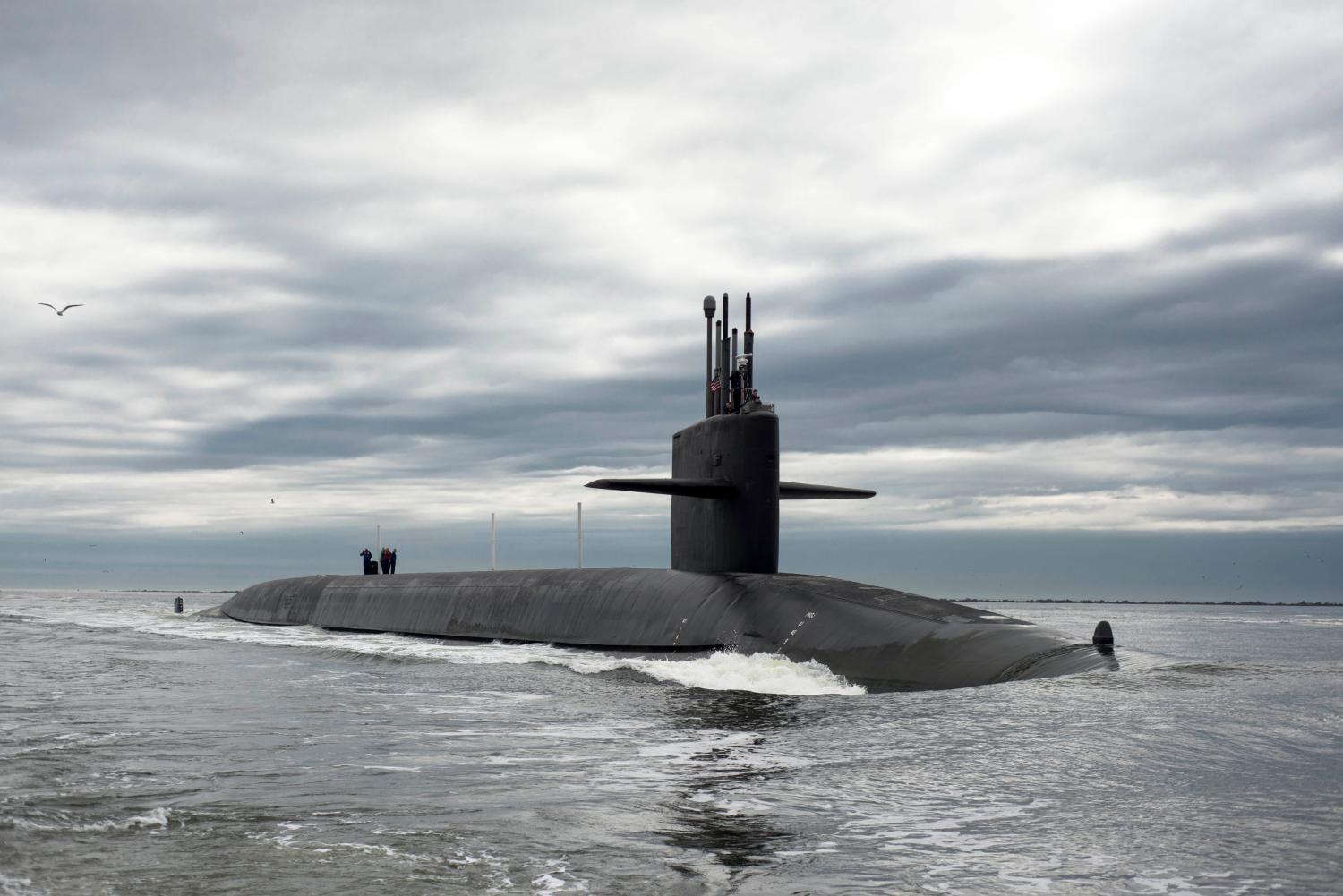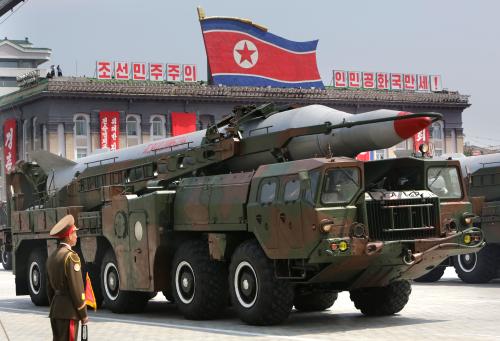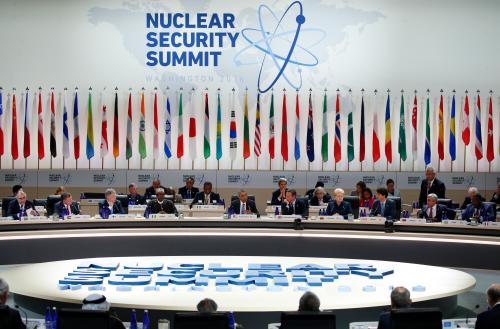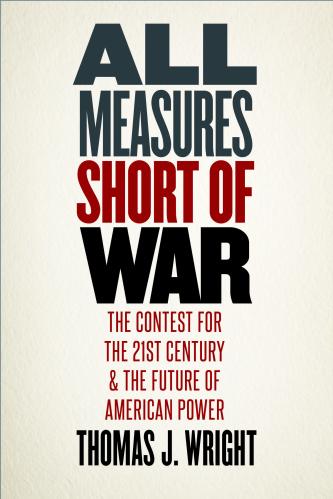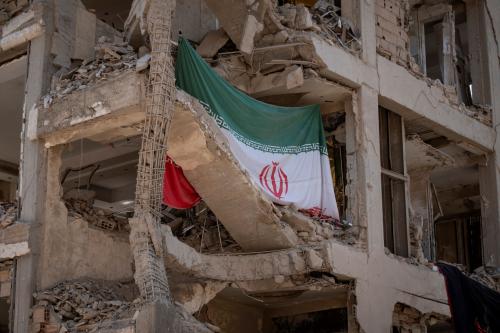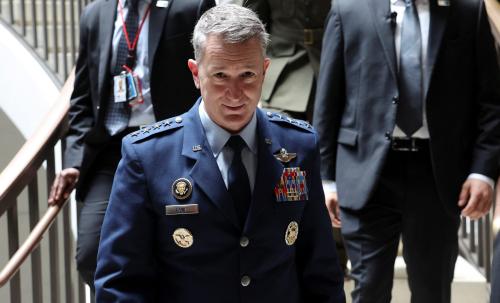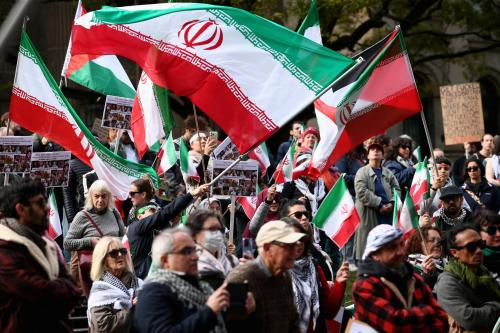Over the past 24 months, the Brookings Institution has convened a group of prominent Americans with deep experience in matters of nuclear weapons policy, regional security affairs, and/or arms control questions to examine recent disturbing international security developments and consider their implications for U.S. policies aimed at deterring potential adversaries and assuring U.S. allies and other security partners. This report is based on the group’s deliberations.
In conducting its Nuclear Posture Review, the Trump administration needs to consider how best to meet U.S. deterrence requirements in a changing security environment. Today’s most pressing challenges to U.S. deterrence goals come not from the threat of a massive nuclear attack against the U.S. homeland but from the possibility that nuclear-armed adversaries will use the threat of escalation to the nuclear level to act more aggressively in their regions and prevent the United States from coming to the defense of its allies and partners.
A key priority must therefore be to reinforce deterrence at the regional level. That will require strengthening U.S. and allied conventional military capabilities, ensuring the credibility of the forward-deployed and -deployable components of the U.S. extended nuclear deterrent, and maintaining the solidarity and resolve of U.S. alliances. It will also require modernizing U.S. central strategic systems and supporting infrastructure, which remain the bedrock of U.S. deterrence policy, both in extending deterrence and providing assurance to U.S. allies, and in deterring direct attacks on the American homeland.
Deterring Russia
A key concern is that Russia might exploit its local conventional military advantage in the Baltic region by engaging in aggression against a NATO ally and then threaten or employ limited nuclear strikes to compel NATO to back down and allow Moscow to consolidate the gains of its aggression. The United States and its NATO allies should continue to augment their forward conventional military presence; reinforce their extended nuclear deterrent by completing the B61-12 life extension program and replacing current dual-capable aircraft (DCA) over the next decade with F-35s; and give non-basing countries a greater role in the nuclear deterrence mission. In the European context, they should also seek a dialogue with Russia aimed at reducing tensions and avoiding dangerous incidents and miscalculations. At the global level, the United States should pursue wide-ranging “strategic stability talks” with Russia.
Deterring North Korea
North Korea (the Democratic People’s Republic of Korea, or DPRK) poses the most acute near-term threat to the United States and its Asian allies. Washington and its Asian partners should strengthen conventional deterrence; reduce the coercive value of the DPRK’s missiles through integrated regional missile defense and conventional strike capabilities; and ensure the credibility of extended nuclear deterrence through a combination of U.S. central strategic systems and U.S. forward-deployable DCA, perhaps deploying the latter more persistently or permanently in South Korea (but not stationing U.S. nuclear weapons there). In a crisis, Washington should reduce Pyongyang’s incentives to initiate the use of nuclear weapons, signaling that North Korean restraint would be reciprocated, but that DPRK escalation would have grave implications for regime survival.
Deterring China
The principal challenge to U.S. and allied interests comes not from China’s nuclear programs but from a major buildup of its conventional forces aimed at eroding U.S. conventional military superiority in the Western Pacific. The United States should maintain a strong conventional military presence in the region, enhancing its capabilities to operate in a more challenging “anti-access, area denial” environment. Although China will inevitably have an assured nuclear retaliatory capability, the United States can preserve the credibility of its extended nuclear deterrent by maintaining key quantitative and qualitative advantages vis-à-vis China in the strategic area. The combination of modernized U.S. central strategic systems and forward-deployable DCA can provide such an edge, augmented if necessary by more regular regional deployments of U.S. strategic assets (though without nuclear weapons). While taking steps to reinforce deterrence, the United States should seek to dispel Chinese concerns that its programs are aimed at negating China’s nuclear deterrent. China has so far resisted a meaningful U.S.-China dialogue aimed at promoting a more stable strategic relationship and reducing mutual mistrust and worst-case planning, but the Trump administration should seek to establish such a dialogue.
Deterring Iran
The United States should seek to preserve the Joint Comprehensive Plan of Action (JCPOA) by strictly enforcing Iranian compliance and meeting its sanctions relief commitments so that Tehran receives the benefits to which it is entitled. It should also seek to dissuade Tehran from pursuing a large-scale enrichment capacity when the agreement’s nuclear restrictions expire after 15 years. At a minimum, the United States and its partners should press Iran to defer the expiration dates for several years, perhaps offering to address Iran’s concerns about remaining U.S. sanctions in return for longer-lasting nuclear restrictions. But if Iran is unwilling to forgo or defer a large enrichment program, the U.S. president, with the support of Congress, could declare that it is the policy of the United States to prevent Iran from acquiring nuclear weapons, if necessary with the use of military force.
Nuclear Terrorism
Preventing and deterring nuclear terrorism must remain a top national security priority, including by countering the terrorists themselves; denying access to nuclear weapons, technologies, and materials; holding accountable any entity facilitating nuclear terrorism; and strengthening homeland security.
Modernization
With all legs of the Nuclear Triad approaching the end of their expected service lives, it is essential to proceed with modernization. Some signatories believe that, especially given the high cost of recapitalizing the Triad, U.S. deterrence requirements could be met with fewer deployed systems than envisaged in the current “program of record,” which includes 12 Columbia-class ballistic missile submarines (SSBNs), 400 deployed intercontinental ballistic missiles (ICBMs), and 80-100 B-21 bombers, and that modernization of the ICBM leg could be deferred or not pursued at all. However, other members of the group believe the current plan for modernizing each leg of the Triad should be implemented and that the costs of modernization, given the high priority of deterrence, are affordable. Indeed, some members believe that planned numbers may not be adequate if the security environment continues to erode.
Plans for modernizing nuclear command, control, and communications systems as well as the nuclear weapons industrial complex should be expeditiously implemented. So should the strategic plan for the nuclear weapons stockpile, including the completion of warhead life extension programs and the “3+2” strategy for transitioning from 11 to five warhead types. While new nuclear weapons are not necessary, most members of our group believe that, in order to sustain necessary technical expertise, U.S. weapons laboratories should be allowed to explore alternative design concepts and build prototypes of some designs, so long as this is done without nuclear testing, without introducing new designs into the stockpile, and without devising new missions for nuclear weapons. Some others believe this would contravene the Obama administration’s policy not to pursue new nuclear weapons.
Members of the group also differ on a few other modernization issues. For example, supporters of the Long Range Stand-Off (LRSO) air-launched cruise missile maintain that proceeding on schedule with the LRSO is necessary to avoid a gap in air-delivered deterrence capabilities, while critics argue that the LRSO is redundant given the penetrating capability of the B-21 and can be deferred until risks to bomber penetration justify a stand-off weapon.
Proponents of restoring the nuclear capability of the Tomahawk sea-based cruise missile (Tomahawk land-attack missile, nuclear, or TLAM-N) contend that it would bolster extended deterrence and assurance in both Europe and Asia, whereas opponents assert that it is not needed for extended deterrence and that reviving a system retired a decade ago would be viewed domestically and internationally as a step backward.
Nuclear Weapons Employment Policies
Although the likelihood that the United States would use nuclear weapons in response to a non-nuclear attack is very limited, formally adopting a “sole purpose” or “no first use” policy could erode confidence on the part of some U.S. allies in the U.S. extended deterrent and should not be pursued under current circumstances.
While an adversary’s strategic and other military-related assets should remain a central part of the target base held at risk by U.S. forces, the administration should consider whether including a limited number of high-leverage infrastructure sites (e.g., electricity generation, communications nodes) in the target mix—and holding them at risk with precision-guided conventional strike weapons to minimize collateral civilian damage—would strengthen deterrence by threatening disruptive outcomes that today’s leaders of potential adversary countries would regard as unacceptable.
Members of the group believe that, in the current security environment, changes in the alert status of the Triad are not warranted. At the same time, some members maintain that the United States should adopt a policy that, in the event early warning sensors detect a possible massive nuclear attack, the planning assumption would be that the president would wait for a confirmed nuclear detonation before ordering a nuclear response. They believe that moving to a policy of confirmed detonation—and not executing the option to “launch under attack” (LUA)—would give the president more time to make such a fateful decision and to eliminate the risk, however small, of a catastrophic false alarm. Other members would retain the current approach toward LUA, arguing that deterrence is strengthened if a potential attacker believes the U.S. president may launch U.S. ICBMs if an attack is underway and that effective warning systems and layers of technical and procedural safeguards essentially rule out false alarms.
On force levels, the signatories believe U.S. deterrence requirements can be met with a properly designed force structure at a level of roughly 1,000 deployed strategic warheads, assuming that the New Strategic Arms Reduction Treaty (New START) remains in effect, that New START counting rules are used for bomber weapons, and that the Russians join in reducing to that level. Any change in the number of U.S. nuclear weapons deployed in Europe should depend on the evolution of the threat from Russia and agreement among NATO members. Implementation of current plans to modernize the Department of Energy’s nuclear weapons complex will reduce the number of non-deployed nuclear weapons required as a technical or geopolitical hedge. And although conventional systems inherently lack the deterrent value of nuclear weapons and cannot fully substitute for them, integrating non-nuclear systems into U.S. deterrent planning could reduce the number of nuclear weapons required.
Missile Defense
In the congressionally mandated review of U.S. missile defense policy, the administration should reaffirm the goal of a limited homeland missile defense and should not seek the capability to protect U.S. territory against the large-scale attacks that Russia and increasingly China are capable of mounting. At the same time, in light of advances in DPRK missile programs, the administration should consider how best to further upgrade homeland defenses against a North Korean attack, including by increasing the number of Ground-Based Interceptors (GBIs) accompanied by demonstrated improvements in GBI reliability and strengthened sensor capabilities.
On regional missile defenses, the United States should work with South Korea and Japan on a regional missile defense against North Korea, and U.S.-Japanese missile defense cooperation should seek to protect Japan and U.S. forces there against small-scale Chinese missile attacks. In Europe, the United States should complete the Polish site for SM-3 missile interceptors but consideration should be given to not making the site operational if Iran suspends the flight testing of missiles capable of striking Europe. Washington and its NATO allies should also pursue a limited theater defense mission that would seek to protect NATO’s power projection capabilities against Russian ballistic and cruise missiles.
Arms Control
With the near-term outlook bleak for additional formal U.S.-Russian agreements, early priority should be given to conducting strategic stability talks aimed at addressing each other’s strategic concerns as well as to extending New START for five years beyond its scheduled expiration in 2021.
As regards the Intermediate-Range Nuclear Forces (INF) Treaty, the United States should make a proposal that would verifiably ban the deployment of Russian’s INF-prohibited cruise missiles and address Moscow’s concerns about U.S. compliance, while taking steps, such as deploying additional air and sea conventional capabilities, to demonstrate that the Russian violation will not go unanswered. In the event Russia rejects such a proposal and continues its non-compliance with the INF Treaty, the United States and its allies should sustain and, if necessary, augment those steps. To address Russia’s advantage in non-strategic nuclear weapons in the absence of formal measures, Washington should pursue confidence-building arrangements (e.g., no deployment of U.S. weapons in “new” NATO members, no Russian deployment within a certain range of NATO territory). Moreover, the administration should propose a U.S.-Russian executive agreement on missile defense transparency in which the two sides would exchange annual declarations providing the number of key missile defense elements (e.g., interceptors and radars) they currently possess and projecting those numbers for each year over the following 10 years.
The Treaty on the Prohibition of Nuclear Weapons, adopted on July 7, 2017, with the vote of 122 countries, will enter into force when 50 countries have ratified it. Given the opposition of all the nuclear-armed states as well as countries that rely on the United States for extended deterrence, the treaty will not advance its goal of accelerating nuclear disarmament. The United States should continue to oppose the treaty, making clear that it cannot establish new “customary” international law, ensuring that it does not in any way undermine or replace the Nuclear Non-Proliferation Treaty (NPT) as the established global non-proliferation regime, and countering attempts to use the ban to undermine support for burden-sharing and extended deterrence in Western democracies. At the same time, it should engage with “ban treaty” proponents with a view to ensuring that differences over the treaty do not adversely affect prospects for the 2020 NPT Review Conference.
With no currently foreseeable need to test nuclear weapons, the administration should continue the U.S. 25-year testing moratorium and join other avowed testing powers (other than the DPRK) in a joint political commitment to refrain from testing for at least 10 more years.
The administration should reaffirm the ultimate goal of a world without nuclear weapons. While conditions for achieving that goal are unlikely to exist for the foreseeable future, renouncing it would needlessly damage the U.S. ability to play a worldwide leadership role in reducing nuclear dangers.
Sustaining Consensus
U.S. deterrence policies and plans must be sustainable over the long term and therefore must achieve and maintain a bipartisan national consensus, including in support of the funding needed for modernization in coming decades. The Trump administration should therefore pursue a balanced approach that has wide appeal across the political spectrum—one that combines a strong commitment to ensure modern, effective deterrence at both the regional and global levels with a continuing commitment to promote stability and reduce nuclear dangers through dialogue and further arms control efforts.
The Brookings Institution is committed to quality, independence, and impact.
We are supported by a diverse array of funders. In line with our values and policies, each Brookings publication represents the sole views of its author(s).


